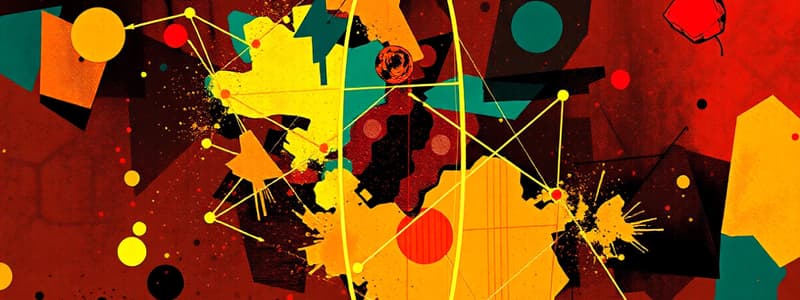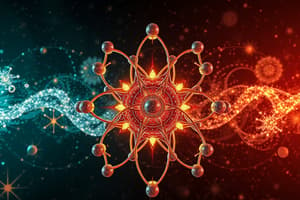Podcast
Questions and Answers
Study Notes
Grade 7 Science Exam Questions
- Instructions for answering the exam: Answer all questions on the provided answer sheet. Clearly shade your selection. If you make a mistake, rub it out and mark the correct answer.
Question 1
- What is the charge of a neutron?
- No charge
Question 2
- What is the number of electrons in the first shell of an atom?
- 2
Question 3
- What is the relationship between the number of protons and electrons in an atom?
- The number of protons is equal to the number of electrons.
Question 4
- What is the term for the arrangement of electrons in energy levels around the nucleus of an atom?
- Electron configuration
Question 5
- What is the atomic number of an atom equal to?
- The number of protons in the nucleus
Question 6
- What is the atomic mass of an atom equal to?
- The number of protons and neutrons in the nucleus
Question 7
- What is the maximum number of electrons that can occupy the second shell?
- 8
Question 8
- Calcium has an atomic number of 20. What is the electronic configuration of the element Calcium (Ca)?
- 2, 8, 8, 2
Question 9
- What do the circles represent in a Dot and Cross diagram?
- Electrons
Question 10
- Chlorine has an atomic number of 17. What is the electronic configuration of the element Chlorine (CI)?
- 2, 8, 7
Question 11
- What happens to the particles in a liquid as they are heated?
- They move faster and escape from the surface of the liquid.
Question 12
- What is an element?
- A substance made up of only one type of element.
Question 13
- What is the term for the fundamental building block of all materials?
- Atom
Question 14
- What happens to the particles in a gas as it is cooled?
- They move slower and come closer together.
Question 15
- What is the term for a pure substance that is made up of two or more different types of atoms chemically combined?
- Compound
Question 16
- What occurs when the particles in a gas are cooled?
- They move slower and come together.
Question 17
- What is the fundamental building block of all materials?
- Atom
Question 18
- What is the term for a pure substance that is made up of two or more different types of atoms chemically combined?
- Compound
Question 19
- What is matter?
- Anything that has mass and volume.
Question 20
- What is an atom?
- A small particle that makes up matter.
Question 21
- Which of the following is an example of an element?
- Sodium chloride (NaCl)
Question 22
- Which part of an atom has a positive charge?
- Proton
Question 23
- What is the atomic number of an element?
- The number of protons in the nucleus of an atom
Question 24
- What does the number of protons in an atom determine?
- The element's identity
Question 25
- Which of the following particles is found outside the nucleus of an atom?
- Electron
Question 26
- Which of the following elements is a noble gas?
- Helium (He)
Question 27
- What is the atomic symbol for Sodium?
- Na
Question 28
- Which particle is neutral and has no charge?
- Neutron
Question 29
- What is a molecule?
- Two or more atoms bonded together
Question 30
- Which of the following is a compound?
- Water (H₂O)
Question 31
- What is the simplest form of a substance that cannot be broken down chemically?
- Element
Question 32
- How many atoms are in a molecule of carbon dioxide (CO₂)?
- Three
Question 33
- Which of the following is true about a compound?
- It consists of two or more different types of atoms chemically bonded.
Question 34
- Which of the following compounds contains two different elements?
- NaCl
Question 35
- What is the difference between a molecule and a compound?
- A molecule can have one type of element, while a compound has two or more.
Question 36
- Which of the following is true about elements in the same group on the periodic table?
- They have similar chemical properties
Question 37
- Which of the following elements is a metalloid?
- Boron (B)
Question 38
- Which of the following is an example of a molecule made up of two atoms of the same
element?
- Nitrogen (N₂)
Question 39
- What is a chemical reaction?
- A process that breaks and forms bonds between atoms.
Question 40
- Which is the main difference between mixtures and compounds?
- Mixtures are not chemically combined, while compounds are chemically combined.
Question 41
- What is the term for the smallest particle that all matter is made of?
- Atom
Question 42
- How many electrons can the first shell of an atom hold?
- 2
Question 43
- What is formed when two or more different types of atoms are bonded together?
- Molecule
Question 44
- What is the term for the arrangement of atoms in an element?
- Molecule
Question 45
- What is the purpose of the atomic number of an element?
- To determine the number of protons in the nucleus.
Question 46
- What is the term for a group of atoms bonded together?
- Molecule
Question 47
- What is the location of protons and neutrons in an atom?
- In the nucleus.
Question 48
- What is the maximum electron capacity of the 2nd shell?
- 8
Question 49
- What is the charge of an electron?
- Negative
Question 50
- What is the term for a group of atoms bonded together?
- Molecule
Question 51
- What determines the identity of an element?
- Number of protons
Question 52
- What is the primary process by which sediments are converted into sedimentary rocks?
- Compaction and cementation
Question 53
- Which of the following statements best describes the relationship between sedimentary rocks and metamorphic rocks?
- Sedimentary rocks can undergo heat and pressure to become metamorphic rocks.
Question 54
- Which of the following statements about the formation of sedimentary rocks is not correct?
- The rock cools slowly underground
Question 55
- Rocks that have been formed from other rocks due to intense heat and pressure are called:
- Metamorphic rocks
Question 56
- Which of the following is not considered an agent of change in the rock cycle?
- Time
Question 57
- What role does chemical reaction play in the rock cycle?
- Chemical reactions are essential in weathering of rocks and the formation of sediments
Question 58
- What happens to metamorphic rocks when subjected to extreme heat?
- They can melt to form magma
Question 59
- What type of rock is formed by the cooling and solidification of lava?
- Extrusive igneous rock
Question 60
- What geological process involves breaking down rocks into smaller fragments?
- Weathering and erosion
Question 61
- Which of the following describes how igneous rocks are formed?
- From the cooling and solidification of magma or lava
Question 62
- What influences the texture of igneous rocks?
- The rate of cooling of magma or lava
Question 63
- Sedimentary rocks are typically formed through which process?
- Accumulation and cementation of sediments
Question 64
- Which statement accurately represents metamorphic rocks?
- They can originate from any pre-existing rock type
Question 65
- What is a characteristic feature of metamorphic rocks?
- Foliation texture
Question 66
- What was likely the first type of rock to form in the Earth's crust was most likely:
- Igneous
Question 67
- What happens to rocks if they are buried deep in the Earth at high temperatures and pressures?
- They break down into smaller particles
Question 68
- What is the initial stage of a star's life cycle?
- Protostar
Question 69
- During which stage does a star, like our Sun, spend most of its life?
- Main sequence star
Question 70
- What happens to a star once it exhausts its hydrogen fuel?
- It becomes a red giant
Question 71
- What is a characteristic of a white dwarf star?
- It emits no light
Question 72
- What defines a black hole in terms of gravity?
- Light cannot escape its gravitational pull
Question 73
- What is the final stage of a massive star's life cycle after the supernova?
- Black Hole
Question 74
- What happens to the outer layers of a star when it becomes a red giant?
- They expand massively and become cooler
Question 75
- What is created during a supernova event?
- New stars only
Question 76
- The variable that you measure is the –
- Dependent Variable
Question 77
- How many independent variables can be tested in a controlled experiment?
- One
Question 78
- What is a prediction?
- An educated guess
Question 79
- An experiment is performed on plants to see how different liquids affect plant growth. Each plant in the experiment is given a different liquid; water, apple juice, or milk. Each plant has the same amount of soil, same amount of sunlight, and the same amount of liquid. In this investigation, what is the independent variable.
- Different liquids
Question 80
- Mr. S set up an experiment to see how the mass of a ball affects the distance it rolls off a ramp. Identify the dependent variable.
- Distance traveled by the ball
Question 81
- A student is planning an experiment to find out how the height from which he drops a ball affects how high the ball bounces. What is the control variable?
- The ball used
Question 82
- The measurable factor in an experiment is known as the:
- Dependent Variable
Question 83
- An experiment is performed on plants to see how different liquids affect plant growth. Each plant in the experiment is given a different liquid: water, apple juice, or milk. What should be kept constant?
- Type of plant, soil, amount of sunlight
Question 84
- In an experiment to determine if temperature affects the solubility of sugar in water, what is the independent variable.
- The temperature of the water
Question 85
- If you are conducting an experiment to see if the type of fertilizer affects plant growth, what would the dependent variable be?
- The growth of the plants
Question 86
- What is the primary role of an independent variable in an experiment?
- It is changed by the researcher to observe an effect.
Question 87
- Which statement accurately describes a dependent variable?
- It is the outcome measured in response to the independent variable.
Question 88
- What is the significance of control variables in an experiment?
- They ensure changes to the dependent variable are due to the independent variable.
Question 89
- In a well-designed experiment, how should independent variables be presented?
- On the x-axis of a graph.
Question 90
- Which statement about relationships between independent and dependent variables is true?
- The dependent variable is expected to change in response to the independent variable.
Question 91
- Which of the following describes control variables?
- They are kept constant to prevent them from influencing the dependent variable.
Question 92
- What could happen if control variables are not properly managed in an experiment?
- Results may be invalid due to extraneous influences.
Studying That Suits You
Use AI to generate personalized quizzes and flashcards to suit your learning preferences.




